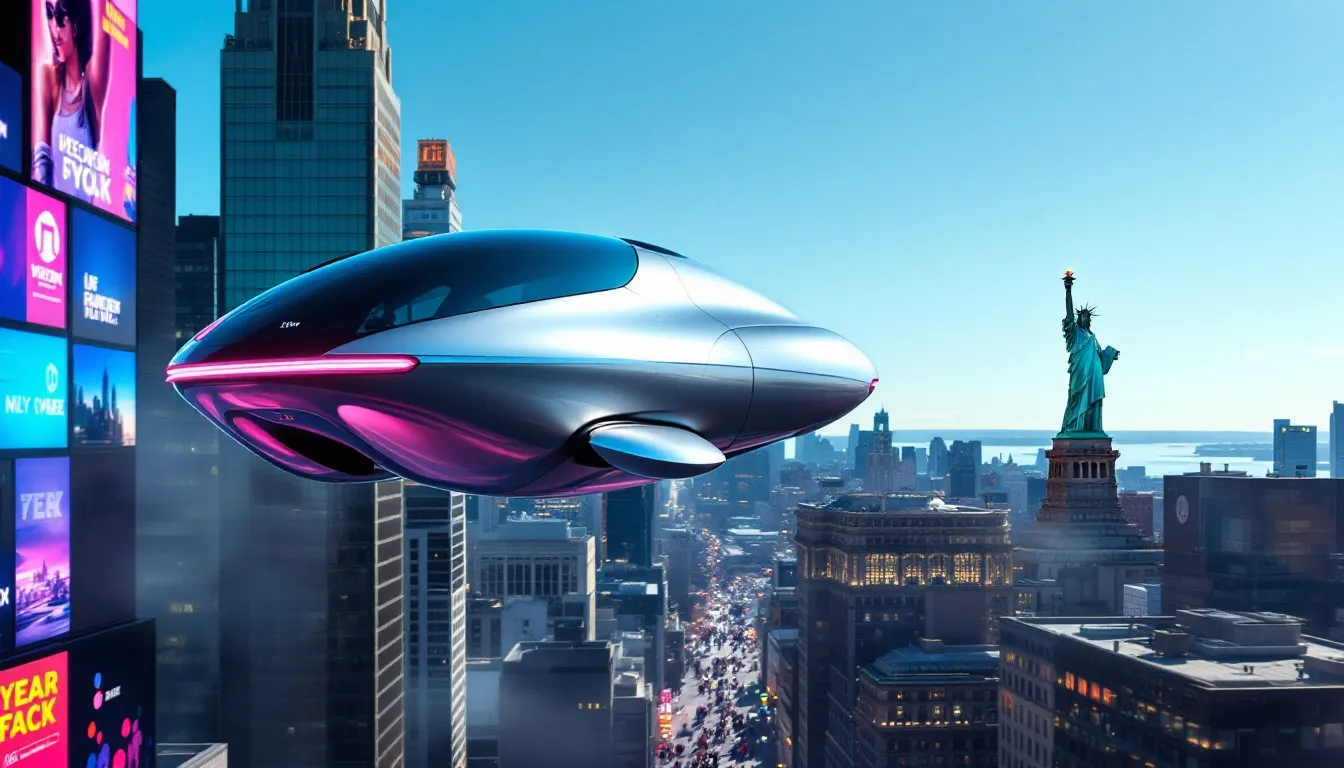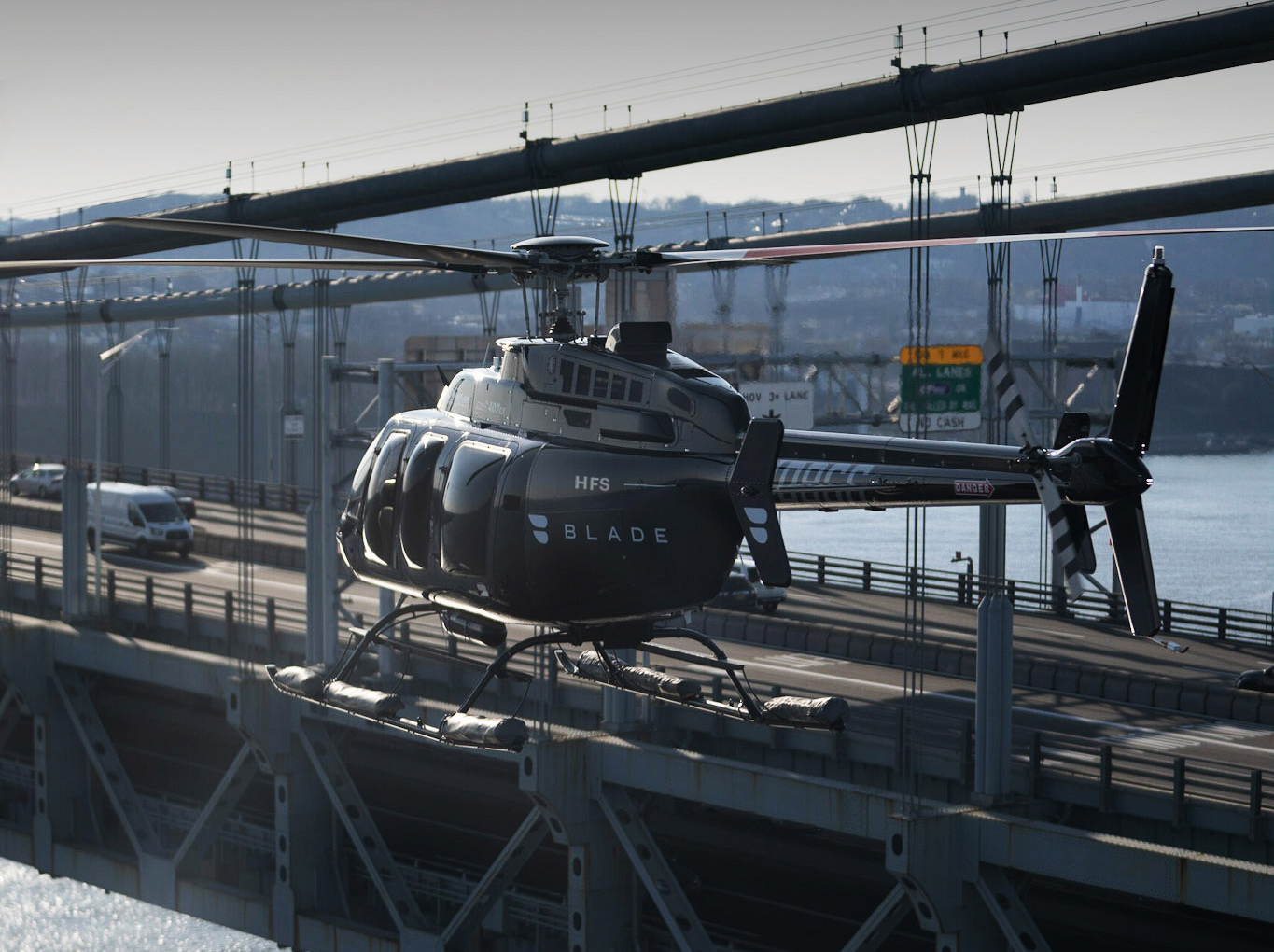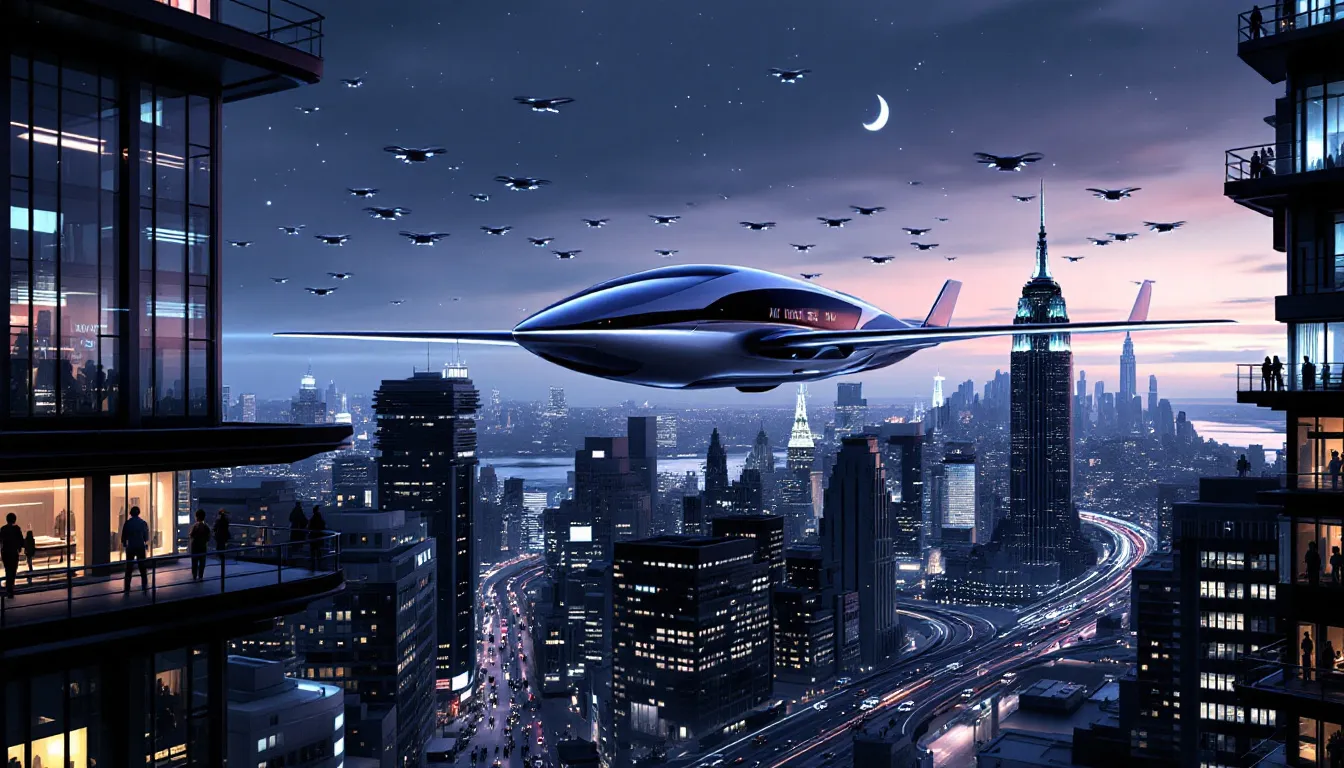NYC Air Taxi Services: Fast, Affordable Travel from Manhattan to JFK
NYC air taxi services will soon make travel from Manhattan to JFK and other airports much quicker. Launching in 2025, these electric air taxis promise to cut travel times significantly. In this article, learn about the technology, costs, and benefits of these new urban air services.
Key Takeaways
Key players like Joby Aviation and Delta Air Lines are set to launch NYC’s electric air taxi service by 2025, aiming for rapid urban air mobility.
Electric air taxis promise to drastically reduce travel times across the city, offering quick connections to major airports while maintaining competitive pricing similar to traditional rides.
Stringent pilot training and FAA regulations ensure safety standards are met, fostering public confidence in the operation of electric air taxis amid increasing competition in the air taxi market.
Exploring NYC's Electric Air Taxi Service

NYC’s electric air taxi service is spearheaded by key players like Joby Aviation, Delta Air Lines, and Uber, with a targeted launch year of 2025. Joby Aviation aims to operate a fleet of 850 electric air taxis by 2026, each capable of performing 40 flights daily. This ambitious plan underscores a significant milestone in urban air mobility, marked by Joby’s first successful air taxi flight in New York City.
Archer Aviation is also gearing up to launch its commercial air taxi services in New York City by 2025, focusing on routes connecting Manhattan with the three main area airports, including the downtown manhattan heliport. These air taxis will utilize electric vertical takeoff and landing (eVTOL) technology, allowing them to operate efficiently in urban environments. With growing demand for quick and reliable transportation, these services are set to become integral to NYC’s transportation network.
With the involvement of major companies like Uber, known for its Uber Elevate initiative, and Delta Air Lines, the electric air taxi service is not just a distant dream but a rapidly approaching reality. The collaboration between these industry giants promises to bring a seamless, fast, and sustainable mode of transportation to New Yorkers, redefining how people travel in the city.
Inside the Electric Aircraft: What to Expect
Step inside an electric air taxi, and you’ll immediately notice the emphasis on passenger comfort and convenience. The cabin design prioritizes personal space with a 32-inch seat pitch, ensuring a comfortable journey even on short flights. Panoramic windows flood the cabin with natural light, offering passengers breathtaking views of the cityscape below.
The interior of these electric aircraft is thoughtfully designed to accommodate all your travel essentials. Spacious luggage holds and interior compartments provide ample space for both carry-on and checked baggage. This attention to detail ensures that passengers can travel comfortably without worrying about storage constraints.
Advanced design and innovative technology in these electric aircraft transform the passenger experience. From the moment you board, the journey is designed to be smooth, quiet, and visually stunning, setting a new standard for urban air travel.
For travelers who value not only speed but also an elevated level of service, Blade offers a premium air travel experience. With a focus on seamless connections, Blade’s app allows passengers to easily book their flights, coordinate ground transport, and even access exclusive lounges at select heliport locations. While air taxis promise speed, Blade ensures that every step of your journey is stress-free, blending advanced technology with unparalleled customer care.
Pilot Requirements for NYC Air Taxis
Operating an electric air taxi in New York City requires pilots to undergo specialized training programs tailored to the unique characteristics of eVTOL aircraft. These training programs cover everything from basic flight principles to advanced safety protocols and emergency procedures. Pilots must also obtain advanced certifications specific to electric vertical takeoff and landing vehicles, ensuring they possess the necessary skills and knowledge.
Continuous training and skill assessments are mandated to maintain high proficiency levels. This ongoing education ensures that pilots stay up-to-date with the latest technological advancements and safety standards, providing passengers with a safe and reliable air taxi service. The Federal Aviation Administration (FAA) plays a critical role in overseeing these certifications and maintaining stringent safety standards.
With these rigorous requirements in place, passengers can rest assured that they are in capable hands. Comprehensive training and strict regulatory oversight ensure that NYC’s electric air taxi pilots are among the best in the industry.
Did you know that you can get from Manhattan to JFK in under 5 minutes without driving?
Blade offers seamless helicopter transfers from our West 30th Street Lounge in Manhattan to JFK Airport in just 5 minutes from $195 per seat.
Skip the traffic and ditch the stress with Blade's year-round airport service.

Reducing Travel Time Across NYC
One of the most compelling advantages of NYC’s electric air taxi service is the dramatic reduction in travel time. Imagine bypassing the gridlock of New York City streets and arriving at JFK Airport from Downtown Manhattan in just seven minutes. This rapid transit is made possible by the ability of air taxis to avoid ground traffic, offering a swift and efficient alternative to traditional transportation methods.
Air taxis can efficiently connect Manhattan with Kennedy International Airport and other airports like White Plains and Republic Airport. This expanded connectivity further enhances the convenience and practicality of air taxis, making them an ideal solution for short-distance trips between urban centers and nearby airports or smaller cities.
Reducing travel times, electric air taxis enhance the passenger experience and alleviate the stress of typical city commutes. The ability to reach destinations quickly and efficiently transforms the way New Yorkers navigate their city, making long slogs through rush-hour traffic a thing of the past.
While electric air taxis aim to redefine travel, Blade already delivers rapid, efficient transit across the NYC area. For instance, Blade’s helicopter services connect Downtown Manhattan to JFK Airport in just five minutes, all while offering passengers the reliability of a well-established operation. By choosing Blade, you gain the advantage of an experienced provider with a commitment to punctuality and safety, ensuring that your time-sensitive travel needs are met every time.
Pricing and Affordability
The pricing model for NYC’s electric air taxi service is designed to be competitive with traditional transportation options. Initial fares are projected to be similar to Uber Black service initially, at approximately $6 per mile per passenger. This cost structure makes the service accessible to a broader range of passengers, offering an increasingly more affordable service compared to traditional helicopter rides.
Joby Aviation plans to implement a per-seat fare structure, allowing passengers to share rides and reduce individual costs. As demand for these services grows and the fleet expands, the cost per passenger could decrease to around $2 to $3 per mile. This pricing strategy balances affordability with sustainability, ensuring cost-competitiveness while meeting high environmental standards.
The combination of speed, convenience, and affordability positions electric air taxis as a viable alternative to conventional transportation methods. As the technology matures and economies of scale come into play, traveling by air taxi will become an increasingly attractive option for New Yorkers.
Delta Air Lines' Investment in Air Taxis

Delta Air Lines has made a significant investment in the future of urban air mobility, pledging as much as $200 million to Joby Aviation to establish a ‘home-to-airport’ air taxi service. This partnership aims to revolutionize the way passengers travel to and from airports, starting with New York City and Los Angeles. The initial $60 million investment will support the launch of these services, with plans for potential expansion to other locations.
Delta and Joby have a mutually exclusive service arrangement across the US and UK for five years, making this service unique to Delta passengers. This strategic partnership highlights the airline’s commitment to pioneering sustainable and efficient travel solutions.
With Delta’s backing, Joby Aviation is poised to bring its electric air taxi service to market, offering a seamless travel experience from doorstep to airport. This collaboration marks a significant step forward in the commercialization of eVTOL technology and the broader adoption of electric air taxis.
Noise Levels and Environmental Impact
One of the standout features of Joby’s eVTOL aircraft is its low noise profile. During takeoff and landing tests, the noise levels were maintained at below 65 dBA, comparable to a normal conversation. This achievement is a result of meticulous design, including the optimization of propeller number and configuration.
The adjustable propellers on Joby’s eVTOL further reduce noise by altering their tilt, speed, and pitch. This design innovation ensures that the aircraft blends seamlessly with urban noise, minimizing its impact on city environments. The Archer Midnight eVTOL is also anticipated to be quieter than traditional helicopters, with an impressive noise level of just 45 dB.
Beyond noise reduction, electric air taxis offer significant environmental benefits. By utilizing electric propulsion systems, these aircraft produce zero emissions during flight, contributing to cleaner air and a more sustainable urban environment. Low noise and high environmental performance position electric air taxis as key players in the future of green transportation.
Regulatory Approvals and Safety
The safe operation of electric air taxis hinges on stringent regulatory approvals and safety standards. The FAA is responsible for ensuring that new powered-lift aircraft, such as eVTOLs, adhere to high safety standards within the U.S. National Airspace System. To facilitate this, the FAA has established new guidelines and updated regulations specifically for eVTOL aircraft.
In July 2023, the FAA expanded the definition of air carriers to include powered-lift operations. This framework is essential for commercializing electric air taxis, providing a clear pathway for their integration into national airspace. The updated regulations ensure that eVTOLs can operate safely alongside traditional aircraft, maintaining the highest safety standards.
These advancements are crucial for the successful deployment of electric air taxis, ensuring rigorous safety criteria and passenger trust. As the industry moves towards commercialization, these safety measures will build public confidence and acceptance.
Competing Companies in the Air Taxi Market
The air taxi market is becoming increasingly competitive, with several companies vying for a share of this emerging industry. Notable contenders include:
Joby Aviation
Archer Aviation
Embraer’s Eve Air Mobility
Vertical Aerospace (VX4)
Each company brings its own innovations and strategic plans to the table, contributing to the dynamic landscape of urban air mobility.
Archer Aviation’s eVTOL prototype, named Midnight, is a critical aspect of their development efforts. Archer is targeting major cities like Atlanta, Los Angeles, and San Francisco for future air taxi services, in addition to planned routes in Chicago and New York City.
Vertical Aerospace, with its VX4 model, is another key player, adding to the cost competitive pressure on Joby Aviation and Archer. This growing competition drives innovation and ensures that the best solutions rise to the top.
As these companies push the boundaries of technology and efficiency, the future of electric air taxis looks bright, promising more options and better services for passengers.
Did you know that you can get from Manhattan to JFK in under 5 minutes without driving?
Blade offers seamless helicopter transfers from our West 30th Street Lounge in Manhattan to JFK Airport in just 5 minutes from $195 per seat.
Skip the traffic and ditch the stress with Blade's year-round airport service.

Future of Urban Air Mobility in NYC

The future of urban air mobility in NYC is supported by comprehensive planning and regulatory frameworks. The FAA’s Innovate28 plan outlines the integration of advanced air mobility operations into urban environments, providing a roadmap for the safe and efficient deployment of air taxis. Additionally, the FAA has established vertiport design standards to support the necessary infrastructure for these operations.
Eve Air Mobility, backed by Embraer, plans to launch operations with a model designed for four passengers and a range of 60 miles. The Wisk Generation 6 eVTOL stands out with its fully autonomous flight capabilities under human oversight, showcasing the potential for future advancements in this field.
As electric air taxis become more prevalent, they will significantly reduce trip durations and stimulate demand for their services. Mayor Eric Adams has expressed support for this innovative mode of transportation, envisioning a future where air taxis are a common sight in the skies above NYC. This vision aligns with broader trends in urban transportation, positioning NYC as a leader in adopting advanced air mobility solutions.
Bottom Line: NYC Air Taxi Services: Fast, Affordable Travel from Manhattan to JFK
In summary, NYC’s electric air taxi services are set to revolutionize urban transportation, offering a fast, efficient, and eco-friendly alternative to traditional travel methods. With significant investments from major players like Delta Air Lines and the involvement of innovative companies like Joby Aviation and Archer Aviation, the future of urban air mobility looks promising. These air taxis will not only reduce travel times but also contribute to a cleaner and quieter urban environment. As we look forward to the launch of these services in 2025, the potential benefits for New Yorkers and the broader urban landscape are immense.
FAQs: NYC Air Taxi Services
How much does Uber air taxi cost?
The cost of an Uber Air taxi is currently $5.73 per passenger mile, with the goal of reducing it to $1.86 and eventually to $0.44 per passenger mile. Thus, you can expect decreasing prices in the future as the service develops.
What is the expected launch year for NYC’s electric air taxi service?
The expected launch year for NYC’s electric air taxi service is 2025, with Joby Aviation and Archer Aviation at the forefront of this initiative.
How long does it take to travel from Manhattan to JFK using an air taxi?
Traveling from Manhattan to JFK using an air taxi takes approximately seven minutes. This efficient mode of transport significantly reduces travel time compared to traditional methods.
What are the noise levels of these electric air taxis?
The noise levels of electric air taxis vary, with Joby’s eVTOL aircraft operating below 65 dBA, akin to a normal conversation, and the Archer Midnight eVTOL being notably quieter at just 45 dB. Thus, both options present a relatively low-noise solution for urban air travel.
What kind of training do pilots need to operate these air taxis?
Pilots need specialized training programs that emphasize the unique characteristics of eVTOL aircraft, along with advanced certifications and ongoing skill assessments to ensure safety and proficiency.
Disclaimer:
Please be aware that the content on this page has been generated by using artificial intelligence language models and may contain errors, inconsistencies, or outdated information. It is provided as-is without any warranties or guarantees of accuracy. We strongly recommend using this content as a starting point for further research. We disclaim any liability for damages or losses resulting from the use or reliance on this content.